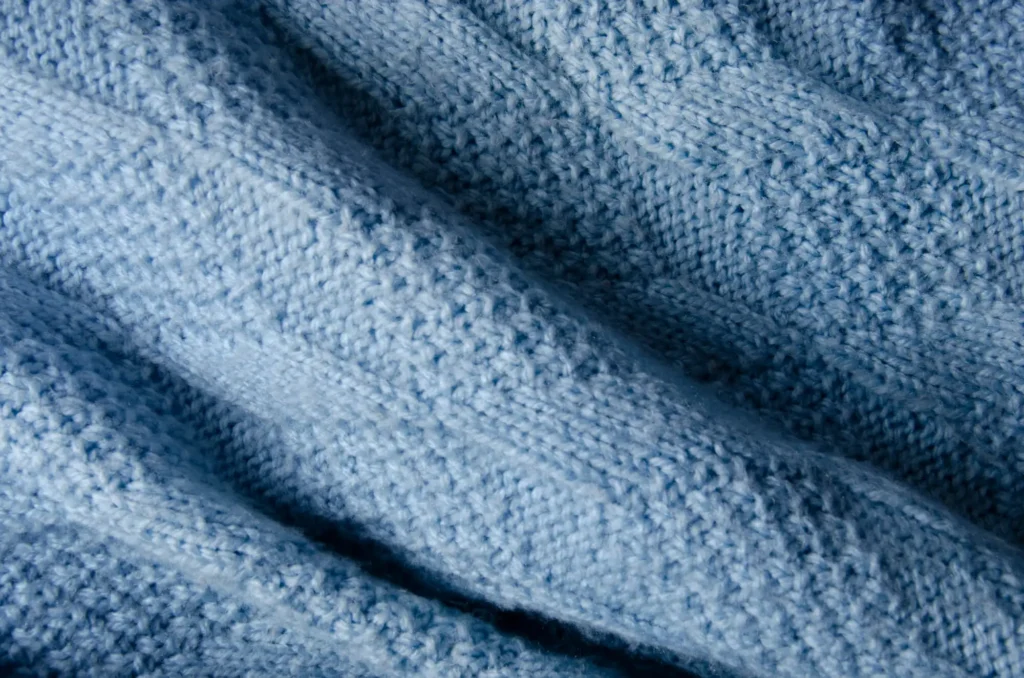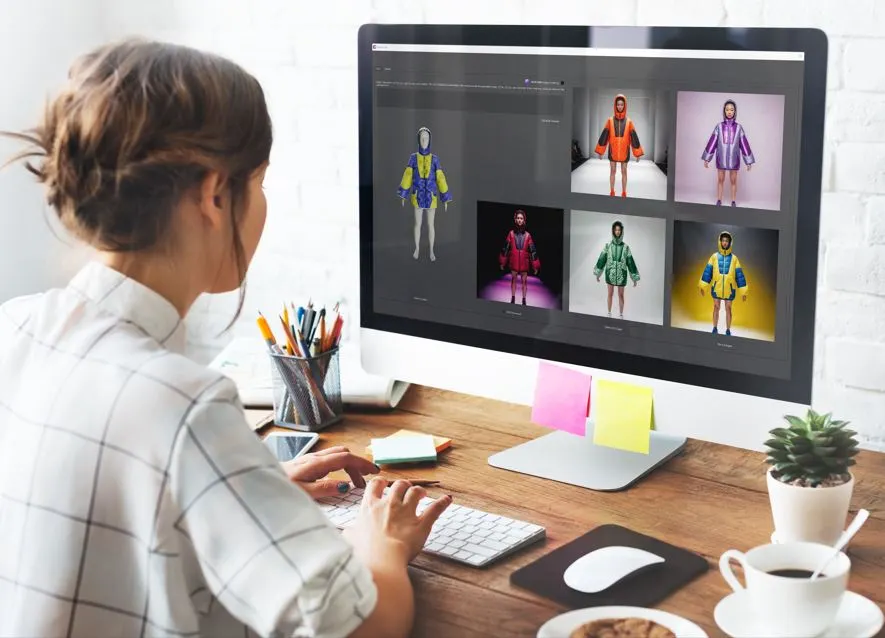Summary
- The color, drape, and texture of a fabric are essential factors to consider when designing a garment.
- Digital tools have transformed the fabric selection process, making it faster and more affordable.
- And the best part? The perfect suite of solutions for fashion design is already here. Start your free trial of Audaces360 today!
The selection of fabric guides the creation of a clothing design from the very beginning. This choice influences every decision from drape and fit to cut and finish.
The color and texture of a fabric determine elements like trims, buttons, and zippers. It’s a way to keep everything aligned and deliver a product that is coherent and attractive to consumers.
Simulating all of this in a digital environment simplifies stages of your design process. In the following lines, we explain how this applies to your creation and the benefits it generates.
Enjoy your reading!
Sumário
Why simulate fabric textures digitally?
Simulating fabric texture digitally streamlines the design process and reduces costs. Fashion designers can visualize the final garment without creating physical samples.
Those who work in the industry know it usually takes multiple prototypes before finalizing a design.
With digital simulation, designers can create the perfect garment. Only then produce the physical sample, when the design is ready to go.
By visualizing details in 3D, you can refine every aspect, including the clothing textures. This results in less material waste and faster time-to-market.
In addition to reducing costs, the process becomes much more sustainable, minimizing the industry’s environmental footprint.
Learn more: How can technology help design clothes with agility?
What is fabric texture?
Fabric texture refers to the physical characteristics of a fabric’s surface. It’s how a fabric feels to the touch and how it looks. With 3D technology, you can simulate it digitally.
There are factors that influence the fabric texture, such as:
- Fiber type: wool, cotton, silk, and synthetic fibers have distinct textures.
- Weave or knit structure: how the yarns are interlaced affects the fabric’s surface.
- Finishing: treatments like brushing, sanding, or embossing can change the texture.
Some ways to describe fabric texture are smooth, rough, soft, and stiff. Your choice of fabric depends on the desired look and feel.
Soft fabrics are perfect for classic, refined clothing. Cashmere is a prime example, known for its luxury and elegance.
For structured pieces, stiffer fabrics work best. Denim is a classic example, ideal for jeans and durable clothing.
Understanding fabric texture is key in fashion design, as it impacts the look and feel of a garment.
Learn more: Complete guide to fabric creation for your apparel business
Types of fabric texture you can simulate digitally
Digital fabric simulation provides many options for copying the appearance and texture of different fabrics.
From delicate lace to luxurious velvet, designers can experiment with a wide range of textures.
Eyelet fabric
Its main feature is the small, regularly spaced holes. Digitally simulating eyelet fabric requires precise control over the placement and size of these perforations.
By representing its airy and open appearance with precision, you can be certain of how the garment will look.
Eyelet fabric is perfect for breezy summer styles. It looks stunning in light colors and flowing silhouettes, creating a fresh and airy feel.
Imagine the beautiful 3D designs you can create with this fabric, especially for wide dresses and skirts!
Learn more: A step-by-step guide on how to draw a dress from scratch
Linen
Linen is famous for its natural fabric texture, with visible slubs and irregularities. Simulating linen’s unique characteristics demands attention to detail, capturing the fabric’s roughness and unevenness.
To recreate it in 3D design software, explore the available texture library. You can quickly apply the texture with just a few clicks.
You might think a simple sketch is enough, but adding a texture will truly transform your design. This will help you accurately recreate the soft, yet sophisticated drape of linen.
Ideal for warm weather, linen is versatile and can be your choice for anything from flowing dresses to breezy blazers.
Eager to learn more about 3D digital design in fashion? Download our free e-book and learn how to transform your design process!
Lace
Lace is a complex fabric with intricate patterns and delicate details. The tools available in digital simulation solutions are ideal to reproduce it with ease.
They can perfectly replicate any lace pattern you can imagine, from floral to geometric. You can even add transparency to see how the lace will look against the skin.
This is perfect for designs that mix lace with other fabrics, like lace cutouts. You can check if the textures of the different fabrics work together. The delicate nature of lace might not pair well with a heavier fabric, for example.
In conclusion, lace is a timeless fashion choice. From small details to whole outfits, it adds a touch of romance to any look. Dresses, blouses, and lingerie are all popular choices for this fabric texture.
Velvet
Crushed, stretched, devoré, flat, silk, polyester – the world of velvet is vast! The good news is you can recreate every type with incredible realism in 3D.
Picture a luxurious evening gown made of silk or devoré velvet. These fabrics are often pricey, making it a big investment to create a physical sample.
With 3D software, you can quickly design and visualize your ideas. You have complete control over the pile direction and patterns, especially for intricate devoré velvets.
You can even experiment with other common applications like upholstery or accessories.
The software allows you to perfectly capture the soft, velvety feel. Once you’re happy with the virtual design, you can move on to creating the physical piece.
Learn more: What is the best 3D design software to invest in?
5 benefits of digital fabric texture simulation
We’ve already seen how digital fabric texture simulation streamlines the design process and reduces costs. But the benefits don’t stop there! Discover how they can improve your day-to-day work:
1) Effortless design creation
Digital fabric simulation speeds up the design process. This happens because professionals can experiment with different textures online, without needing physical samples.
Moreover, advanced software options rely on fashion-focused Artificial Intelligence. They help generate ideas, create variations of garments, and produce even more realistic images of your designs.
Learn more: Discover how to create a collection using digital sketch
2) Infinite texture possibilities

The digital world offers endless possibilities for creating and manipulating fabric textures.
From subtle details to entirely new fabric textures, designers can explore a vast range of options, pushing the limits of creativity.
3) Adjustments at no cost
Unlike traditional methods that involve costly material and labor, digital simulation allows for effortless adjustments.
You can experiment with different fabric textures, colors, and patterns as many times as you want. And guess what? Without any extra costs.
You’ll see a rapid return on your investment, and the quality of your designs will soar.
4) Additional resource for pattern making
By accurately simulating fabric drape and behavior, digital tools provide invaluable insights for pattern makers. The fabric texture information helps create more accurate garments.
This is because they can precisely see how each unique feature of the fabric will align within the garment. Such precision ensures the creation of the correct pattern on the first attempt.
5) Realistic fabric behavior
Digital simulation offers a highly accurate representation of how fabrics will behave in real-world conditions. There’s even the possibility of including everyday scenarios or runaways.
This enables designers to predict fabric drape, movement, and interaction with other materials, leading to more refined designs.
Learn more: The power of art posing and personalized sketches in fashion
Create fabric textures using industry-leading solutions

Audaces Fashion Studio
Audaces Fashion Studio is one of the groundbreaking innovations within Audaces360, our comprehensive suite of solutions for fashion.
This technology empowers fashion designers to create directly on a 3D mannequin. We have developed tools and functionalities to support every stage of the design process.
Experience realistic fabric simulations and visualize your designs with accurate texture representations before production.
This way, you can focus on what truly matters: creating stunning and innovative apparel.
Its intuitive interface and features enable you to examine fit, drape, and movement in different body types. Explore everything, including fabrics, colors, textures, and prints in a few clicks!
Audaces Sofia
Audaces Sofia is our cutting-edge fashion Artificial Intelligence. We have developed it to help you enhance your creations with an unlimited source of inspiration.
It empowers you to transform concepts into reality in a matter of minutes, including fabric texture simulation. Some simple commands are all you need to visualize your fabrics!
Audaces Sofia integrates with Audaces Idea and Audaces Fashion Studio, providing you with the complete solution to create effortlessly.
Focus on your vision while Sofia enhances your workflow, allowing you to explore countless possibilities.
Audaces 3D
Audaces 3D is the essential solution for pattern makers to bring creations to life in a three-dimensional mannequin.
You can test your digital pattern before committing to a physical sample. It helps save time and resources by identifying issues early in the process.
With a range of tools and possibilities, this software transforms the creative and development processes. It allows you to seamlessly experiment with designs featuring the most intricate elements.
Additionally, it enables you to shape your ideas directly in a digital environment, gaining agility and quality in deliveries.
Discover Audaces360 and unlock a world of possibilities for your fashion designs. Explore our comprehensive suite of tools today!
FAQ
Simulating fabric texture digitally streamlines the design process and reduces costs. Fashion designers can visualize the final garment without creating physical samples.
Fabric texture refers to the physical characteristics of a fabric’s surface. It’s how a fabric feels to the touch and how it looks. With 3D technology, you can simulate it digitally.
Eyelet fabric, linen, lace, and velvet are some examples.










